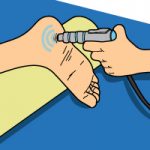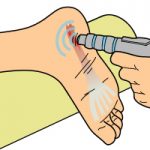What is Extracorporeal Shockwave Therapy?
Extracorporeal Shockwave Therapy (ESWT) involves the use of a handheld device to deliver shockwaves to the injured part of your foot. This is a common treatment for chronic Plantar Fasciitis and other soft tissue injuries that won’t seem to heal through conservative treatments.
ESWT is a non-invasive treatment that is often done as a last resort before surgery. EWST should not be considered unless all other treatment options have failed to give you relief after 6 months to a year.
The Procedure
 The procedure itself should be no more than 15-20 minutes. You will be asked to lie back during the procedure and a gel will be applied to the affected area to help the device move over the bottom of your foot. The shockwaves being delivered to your foot may be either high-energy or low-energy. If they are low-energy shockwaves, any pain felt should be minimal. If the shockwaves are high-energy, treatment can be fairly painful. The procedure is said to work by causing micro-trauma in the soft tissue, which then causes the body to go into healing mode.
The procedure itself should be no more than 15-20 minutes. You will be asked to lie back during the procedure and a gel will be applied to the affected area to help the device move over the bottom of your foot. The shockwaves being delivered to your foot may be either high-energy or low-energy. If they are low-energy shockwaves, any pain felt should be minimal. If the shockwaves are high-energy, treatment can be fairly painful. The procedure is said to work by causing micro-trauma in the soft tissue, which then causes the body to go into healing mode.
There are few complications that come with Extracorporeal Shockwave Therapy. The most common complaint is continued pain.
Extracorporeal Shockwave Therapy can be expensive, so you may want to check with your health insurance provider to see if they will cover the cost.
Outcome
Results of ESWT are mixed, with some people finding relief after treatment and some people finding that their Plantar Fasciitis symptoms persisted. There are studies that suggest only a small percentage of people who get ESWT will see results. Some studies suggest that even in the small group of people who see results, it’s not a big difference from where they were before ESWT.
Results with ESWT are not usually seen immediately, and can take several weeks up to several months to notice. A second treatment may be an option if symptoms persist.
Alternatives
 The fastest, most effective and affordable way to heal your Plantar Fasciitis is through a combination of the following:
The fastest, most effective and affordable way to heal your Plantar Fasciitis is through a combination of the following:
RICE – The RICE method (Rest, Ice, Compression and Elevation) will help get your pain, swelling and inflammation under control. It also helps you avoid doing further damage to your plantar.
Blood Flow – Once the swelling is gone and internal inflammation is at a minimum, blood flow should be stimulated in order to promote healing.
 Proper Footwear – If you have Plantar Fasciitis, it’s important to wear comfortable, supportive footwear that fits you properly. You should also avoid shoes with high heels. Make sure your shoes fit you properly and are not too worn out.
Proper Footwear – If you have Plantar Fasciitis, it’s important to wear comfortable, supportive footwear that fits you properly. You should also avoid shoes with high heels. Make sure your shoes fit you properly and are not too worn out.
Crutches – Keeping the weight off your foot is critical during healing, as it helps you avoid re-injury. Every time you re-injure your foot, you’re setting back your healing further and further.